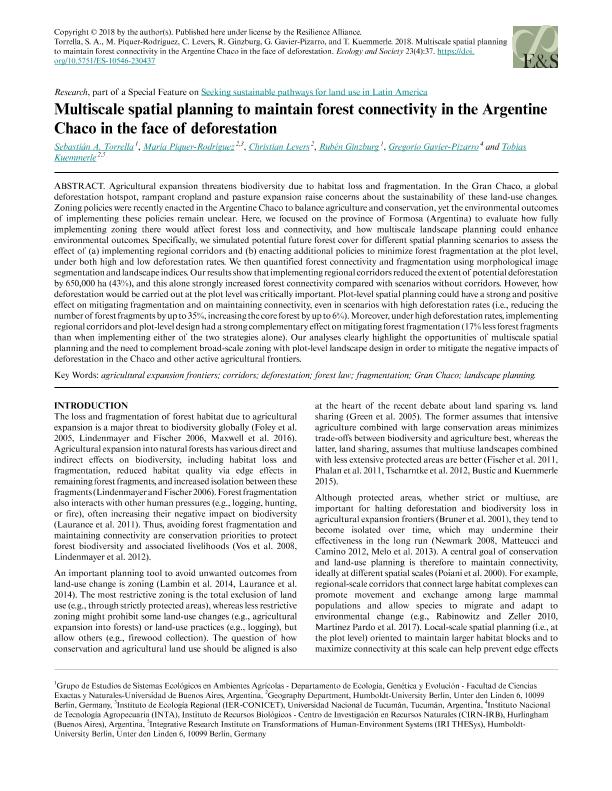Mostrar el registro sencillo del ítem
dc.contributor.author
Torrella, Sebastián Andrés

dc.contributor.author
Piquer Rodríguez, María

dc.contributor.author
Levers, Christian
dc.contributor.author
Ginzburg, Rubén Gabriel

dc.contributor.author
Gavier Pizarro, Gregorio

dc.contributor.author
Kuemmerle, Tobias

dc.date.available
2022-11-17T19:06:37Z
dc.date.issued
2018-12
dc.identifier.citation
Torrella, Sebastián Andrés; Piquer Rodríguez, María; Levers, Christian; Ginzburg, Rubén Gabriel; Gavier Pizarro, Gregorio; et al.; Multiscale spatial planning to maintain forest connectivity in the Argentine Chaco in the face of deforestation; Resilience Alliance; Ecology and Society; 23; 4; 12-2018; 1-19
dc.identifier.issn
1708-3087
dc.identifier.uri
http://hdl.handle.net/11336/178290
dc.description.abstract
Agricultural expansion threatens biodiversity due to habitat loss and fragmentation. In the Gran Chaco, a global deforestation hotspot, rampant cropland and pasture expansion raise concerns about the sustainability of these land-use changes. Zoning policies were recently enacted in the Argentine Chaco to balance agriculture and conservation, yet the environmental outcomes of implementing these policies remain unclear. Here, we focused on the province of Formosa (Argentina) to evaluate how fully implementing zoning there would affect forest loss and connectivity, and how multiscale landscape planning could enhance environmental outcomes. Specifically, we simulated potential future forest cover for different spatial planning scenarios to assess the effect of (a) implementing regional corridors and (b) enacting additional policies to minimize forest fragmentation at the plot level, under both high and low deforestation rates. We then quantified forest connectivity and fragmentation using morphological image segmentation and landscape indices. Our results show that implementing regional corridors reduced the extent of potential deforestation by 650,000 ha (43%), and this alone strongly increased forest connectivity compared with scenarios without corridors. However, how deforestation would be carried out at the plot level was critically important. Plot-level spatial planning could have a strong and positive effect on mitigating fragmentation and on maintaining connectivity, even in scenarios with high deforestation rates (i.e., reducing the number of forest fragments by up to 35%, increasing the core forest by up to 6%). Moreover, under high deforestation rates, implementing regional corridors and plot-level design had a strong complementary effect on mitigating forest fragmentation (17% less forest fragments than when implementing either of the two strategies alone). Our analyses clearly highlight the opportunities of multiscale spatial planning and the need to complement broad-scale zoning with plot-level landscape design in order to mitigate the negative impacts of deforestation in the Chaco and other active agricultural frontiers.
dc.format
application/pdf
dc.language.iso
eng
dc.publisher
Resilience Alliance

dc.rights
info:eu-repo/semantics/openAccess
dc.rights.uri
https://creativecommons.org/licenses/by-nc/2.5/ar/
dc.subject
AGRICULTURAL EXPANSION FRONTIERS
dc.subject
CORRIDORS
dc.subject
DEFORESTATION
dc.subject
FOREST LAW
dc.subject
FRAGMENTATION
dc.subject
GRAN CHACO
dc.subject
LANDSCAPE PLANNING
dc.subject.classification
Ecología

dc.subject.classification
Ciencias Biológicas

dc.subject.classification
CIENCIAS NATURALES Y EXACTAS

dc.subject.classification
Conservación de la Biodiversidad

dc.subject.classification
Ciencias Biológicas

dc.subject.classification
CIENCIAS NATURALES Y EXACTAS

dc.title
Multiscale spatial planning to maintain forest connectivity in the Argentine Chaco in the face of deforestation
dc.type
info:eu-repo/semantics/article
dc.type
info:ar-repo/semantics/artículo
dc.type
info:eu-repo/semantics/publishedVersion
dc.date.updated
2022-11-16T11:45:23Z
dc.identifier.eissn
1708-3087
dc.journal.volume
23
dc.journal.number
4
dc.journal.pagination
1-19
dc.journal.pais
Canadá

dc.description.fil
Fil: Torrella, Sebastián Andrés. Universidad de Buenos Aires. Facultad de Ciencias Exactas y Naturales. Departamento de Ecología, Genética y Evolución; Argentina. Consejo Nacional de Investigaciones Científicas y Técnicas; Argentina
dc.description.fil
Fil: Piquer Rodríguez, María. Universidad Nacional de Tucumán. Facultad de Ciencias Naturales e Instituto Miguel Lillo; Argentina. Universität zu Berlin; Alemania. Consejo Nacional de Investigaciones Científicas y Técnicas; Argentina
dc.description.fil
Fil: Levers, Christian. Universität zu Berlin; Alemania
dc.description.fil
Fil: Ginzburg, Rubén Gabriel. Universidad de Buenos Aires. Facultad de Ciencias Exactas y Naturales. Departamento de Ecología, Genética y Evolución; Argentina
dc.description.fil
Fil: Gavier Pizarro, Gregorio. Instituto Nacional de Tecnología Agropecuaria. Centro de Investigación de Recursos Naturales; Argentina. Consejo Nacional de Investigaciones Científicas y Técnicas; Argentina
dc.description.fil
Fil: Kuemmerle, Tobias. Universität zu Berlin; Alemania
dc.journal.title
Ecology and Society

dc.relation.alternativeid
info:eu-repo/semantics/altIdentifier/url/https://www.ecologyandsociety.org/vol23/iss4/art37/
dc.relation.alternativeid
info:eu-repo/semantics/altIdentifier/doi/http://dx.doi.org/10.5751/ES-10546-230437
Archivos asociados
